
The Battle of Nördlingen took place on 6 September 1634 during the Thirty Years' War. A combined Imperial-Spanish force won a crushing victory over a Swedish-German army.

The Battle of White Mountain was an important battle in the early stages of the Thirty Years' War.

Johann Tserclaes, Count of Tilly was a field marshal who commanded the Catholic League's forces in the Thirty Years' War. From 1620–31, he had an unmatched and demoralizing string of important victories against the Protestants, including White Mountain, Wimpfen, Höchst, Stadtlohn and the Conquest of the Palatinate. He destroyed a Danish army at Lutter and sacked the Protestant city of Magdeburg, which caused the death of some 20,000 of the city's inhabitants, both defenders and non-combatants, out of a total population of 25,000.

Matthias Gallas, Graf von Campo und Herzog von Lucera was an Austrian professional soldier during the Thirty Years' War. He distinguished himself in the first half of the war in service of the Catholic League, in the War of the Mantuan Succession, and as one of Albrecht von Wallenstein's Generals. After carrying out the dismissal and elimination of Wallenstein, Gallas became acting supreme commander of the Imperial Army three times between 1634 and 1647 but he never held the function or authority of a Generalissimo.

The Battle of Rain, also called Battle of the River Lech, took place on 15 April 1632 near Rain in Bavaria during the Thirty Years' War. It was fought by a Swedish-German army under Gustavus Adolphus of Sweden, and a Catholic League force led by Johann Tserclaes, Count of Tilly. The battle resulted in a Swedish victory, while Tilly was severely wounded and later died of his injuries.

The Battle of Breitenfeld or First Battle of Breitenfeld, was fought at a crossroads near Breitenfeld approximately 8 km north-west of the walled city of Leipzig on 17 September, or 7 September, 1631. It was the Protestants' first major victory of the Thirty Years War.

The Second Battle of Breitenfeld, also known as the First Battle of Leipzig, took place on 2 November 1642 at Breitenfeld, some 7.5 kilometres (4.7 mi) north-east of Leipzig, Germany, during the Thirty Years' War. The battle was a decisive victory for the Swedish Army under the command of Field Marshal Lennart Torstenson over an Imperial Army of the Holy Roman Empire under the command of Archduke Leopold Wilhelm of Austria and his deputy, Field Marshal Ottavio Piccolomini, Duke of Amalfi.

Ottavio Piccolomini, 1st Duke of Amalfi was an Italian nobleman whose military career included service as a Spanish general and then as a field marshal of the Holy Roman Empire.
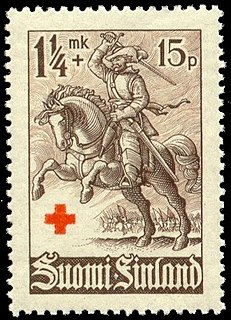
Hakkapeliitta is a historiographical term used for a Finnish light cavalryman in the service of King Gustavus Adolphus of Sweden during the Thirty Years' War. Hakkapeliitta is a 19th-century Finnish modification of a contemporary name given by foreigners in the Holy Roman Empire and variously spelled as Hackapelit, Hackapelite, Hackapell, Haccapelit, or Haccapelite. These terms were based on a Finnish battle cry hakkaa päälle, commonly translated as "Cut them down!"
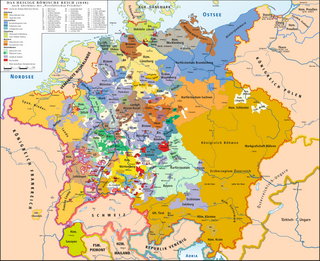
The Battle of Jankau, also known as Jankov, Jankow, or Jankowitz, took place in central Bohemia, on 6 March 1645. One of the last major battles of the 1618 to 1648 Thirty Years' War, it was fought between Swedish and Imperial armies, each containing around 16,000 men. The more mobile and better led Swedes under Lennart Torstensson effectively destroyed their opponents, commanded by Melchior von Hatzfeldt. However, by this stage of the war, the devastated countryside forced armies to spend much of their time trying to support themselves, and the Swedes were unable to take advantage.

Raimondo Montecuccoli was an Italian-born professional soldier who served the Habsburg monarchy. He was also a Duke of Melfi, in the Kingdom of Naples.
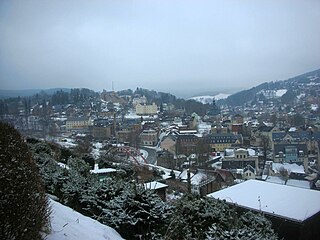
Klingenthal is a town in the Vogtland region, in the Free State of Saxony, south-eastern Germany. It is situated directly on the border with the Czech Republic opposite the Czech town of Kraslice, 29 km southeast of Plauen, and 33 km northwest of Karlovy Vary.
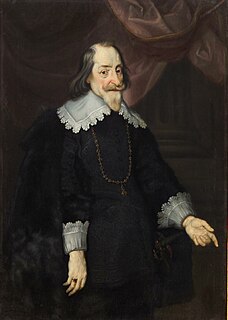
The Treaty of Fontainebleau was signed on 30 May 1631 during the Thirty Years' War, at the Palace of Fontainebleau. It was a pact of mutual assistance between Maximilian I, Elector of Bavaria, and France, for a period of eight years.

The Battle of Herbsthausen, also known as the Battle of Mergentheim, took place near Bad Mergentheim, in the modern German state of Baden-Württemberg. Fought on 5 May 1645, during the Thirty Years War, it featured a French army led by Turenne, defeated by a Bavarian force under Franz von Mercy.

The Battle of Oldendorf on 8 July 1633 was fought as part of the Thirty Years' War between the Swedish Empire and the Holy Roman Empire near Hessisch-Oldendorf, Lower Saxony, Germany. The result was a decisive victory for the Swedish Army.

Lennart Torstensson, Count of Ortala, Baron of Virestad, was a Swedish Field Marshal and military engineer.
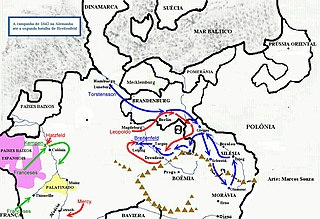
Events from the year 1642 in Sweden
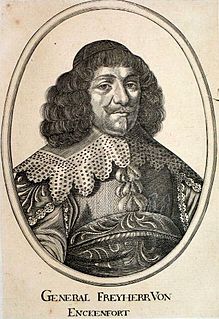
Adrian von Enkevort was a Brabantine nobleman and Generalfeldmarschall who fought during the course of the Thirty Years' War and the Franco-Spanish War (1635–59). Born in 1603, Enkevort followed his father's footsteps becoming an officer, his first success came in 1632 when he distinguished himself at the Battle of Lützen, receiving the rank of Oberstleutnant in the forces of the Holy Roman Empire. He was later sent to the Lorraine front where he assisted Charles of Lorraine in reclaiming his lost realm. After a short spell in the Spanish invasion of Picardy, he returned to Lorraine where he was captured by the French, spending three years in captivity. Upon his return in 1641, he was promoted to Generalfeldmarschall and dispatched to Germany where he campaigned extensively. In 1648, he became the supreme commander of the Bavarian forces, serving in this capacity until the end of the war. He was subsequently ennobled and received the sum of 3,000 Goldguldens for his service during the war. He died in 1663.

Johann Philipp Kratz von Scharffenstein was a German nobleman and field marshal, who fought during the course of the Thirty Years' War. He served with distinction in forces of both the Catholic League and Holy Roman Empire. His poor relationship with the Imperial generalissimo Albrecht von Wallenstein frustrated his plan of becoming the supreme commander of the League's forces. Embittered by this he defected to Sweden, where he attained the rank of field marshal. He was captured at the Battle of Nördlingen (1634) and executed for treason a year later.

The Battle of Kempen was a battle during the Thirty Years' War in Kempen, Westphalia on 17 January 1642. It resulted in the victory of a French-Weimar-Hessian army under the French Comte de Guébriant and the Hessian Generalleutnant Kaspar Graf von Eberstein against the Imperial Army under General Guillaume de Lamboy, who was captured.